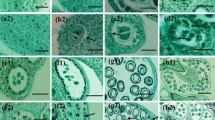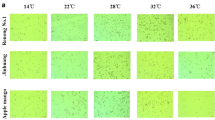Abstract
The reproductive stage of flowering plants is sensitive to high-temperature stresses. High temperature is a major factor influencing pollen grain viability in upland cotton (Gossypium hirsutum). The objective of this study was to identify the relationship between cotton pollen germination percentage and temperature by assaying the pollen germination of four upland cotton cultivars in vitro at different temperatures during the blooming period. The results showed that in vitro pollen germination percentage was related to the culture temperature of pollen germination and the temperature of the square development process. High temperature affected pollen development and germination, and high-temperature tolerance differed among the cotton cultivars. The pollen germination percentage decreased rapidly with changes in the culture temperature from 30 to 39 °C. A culture temperature of 35 °C might be a critical temperature for the pollen viability transition and could be used to screen cotton cultivars that have pollen grains with high-temperature resistance. Before the high-temperature stage, cultivars with rates of decrease in the percentage of pollen germination of less than 41 % at 35 °C relative to the rates at 30 °C might be considered as high-temperature tolerance cultivars, and cultivars with rates of decrease in the percentage of pollen germination greater than 41 % might be considered as susceptible cultivars. The high-temperature stress for pollen grain germination in vitro was greater than 30 °C, and the high-temperature stress for square development might be greater than 33 °C. Boll retention was significant; it was positively correlated with the pollen germination percentage and negatively correlated with temperature during the high-temperature stage. This study provided a method for rapidly screening cultivars (lines) with high-temperature tolerance pollen in upland cotton breeding.




Similar content being viewed by others
References
Barrow JR (1983) Comparisons among pollen viability measurement methods in cotton. Crop Sci 23:734–736
Craufurd PQ, Prasad PVV, Kakani VG, Wheeler TR, Nigam SN (2003) Heat tolerance in groundnut. Field Crop Res 80:63–77
Cross RH, McKay SAB, McHughen AG, Bonham-Smith PC (2003) Heat-stress effects on reproduction and seed set in Linum usitatissimum L. (flax). Plant Cell Environ 26:1013–1020
Erickson AN, Markhart AH (2002) Flower development stage and organ sensitivity of bell pepper (Capsicum annuum L.) to elevated temperature. Plant Cell Environ 25:123–130
Ganguly AR, Steinhaeuser K, Erickson III DJ, Branstetter M, Parish E, Singh N, Drake JB, Buja L (2009) Higher trends but larger uncertainty and geographic variability in 21st century temperature and heat waves. PNAS 106:15555–15559
Goldberg RB, Beals TP, Sanders PM (1993) Anther development: basic principles and practical applications. Plant Cell 5:1217–1229
Herrero MP, Johnson RR (1980) High temperature stress and pollen viability of maize. Crop Sci 20:796–800
Kakani VG, Prasad PVV (2002) Response of in vitro pollen germination and pollen tube growth of groundnut (Arachis hypogaea L.) genotypes to temperature. Plant Cell Environ 25:1651–1661
Kakani VG, Reddy KR, Koti S (2005) Differences in in vitro pollen germination and pollen tube growth of cotton cultivars in response to high temperature. Ann Bot 96:56–67
Lee HW, Kim EJ, Park SS, Choi JH (2012) Effects of climate change on the thermal structure of lakes in the Asian Monsoon Area. Clim Change 112:859–880
Levitin B, Richter D, Markovich I (2008) Arabinogalactan proteins 6 and 11 are required for stamen and pollen function in Arabidopsis. Plant J 56:351–363
Liu Z, Yuan YL (2006) Screening for high-temperature tolerant cotton cultivars by testing in vitro pollen germination, pollen tube growth and boll retention. J Integr Plant Biol 48:706–714
Ma P, Huang J, Cao G, Xu W (2010) Influence of temperature on corona discharge treatment of cotton fibers. Fiber Polym 11:941–945
Mei YJ, Guo WF, Fan SL, Song MZ, Pang CY, Yu SX (2014) Analysis of decision-making coefficients of the lint yield of upland cotton (Gossypium hirsutum L.). Euphytica 196:95–104
Meyer VG (1966) Environmental effects on the differentiation of abnormal cotton flowers. Am J Bot 53:976–980
Misra OP, Kalra P, Rathore SKS, Sinha P (2012) Effect of increasing temperature due to depletion of ozone layer caused by CFC on the dynamics of two competing populations: a model. J Appl Math Comput 38:279–293
Prasad PVV, Craufurd PQ, Summerfield RJ (1999) Fruit number in relation to pollen production and viability in groundnut exposed to short episodes of heat stress. Ann Bot 84:381–386
Reddy KR, Kakani VG (2007) Screening Capsicum species of different origins for high temperature tolerance by in vitro germination and pollen tube length. Sci Hortic 112:130–135
Reddy KR, Reddy VR, Hodges HF (1992a) Effects of temperature on early season cotton growth and development. Agron J 84:229–237
Reddy KR, Hodges HF, Reddy VR (1992b) Temperature effects on cotton fruit retention. Agron J 84:26–30
Reddy KR, Davidonis GH, Johnson AS, Vinyard BT (1999) Temperature regime and carbon dioxide enrichment alter cotton boll development and fiber properties. Agron J 91:851–858
Rodriguez-Garay B, Barrow JR (1988) Pollen selection for heat tolerance in cotton. Crop Sci 28:857–859
Sakata T, Takahashi H, Nishiyama I, Higashitani A (2000) Effects of high temperature on the development of pollen mother cells and microspores in barley Hordeum vulgare L. J Plant Res 113:395–402
Salem MA, Kakani VG, Koti S, Reddy KR (2007) Pollen-based screening of soybean genotypes for high temperatures. Crop Sci 47:219–231
Sarvella P (1964) Variation of cytoplasmic male-sterile cotton with environment. Abstracts of the Annual Meetings of the American Society of Agronomy held at Kansas City, Missouri, pp 78–79
Sato S, Peet MM, Thomas JF (2002) Determining critical pre- and post-anthesis periods and physiological processes in Lycopersicon esculentum Mill. exposed to moderately elevated temperatures. J Exp Bot 53:1187–1195
Singh SK, Kakani VG, Brand D, Baldwin B, Reddy KR (2008) Assessment of cold and heat tolerance of winter-grown canola (Brassica napus L) cultivars by pollen-based parameters. J Agron Crop Sci 194:225–236
Su BD, Jiang T, Jin WB (2006) Recent trends in observed temperature and precipitation extremes in the Yangtze River basin, China. Theor Appl Climatol 83:139–151
Wheeler TR, Craufurd PQ, Ellis RH, Porter JR, Vara Prasad PV (2000) Temperature variability and the yield of annual crops. Agric Ecosyst Environ 82:159–167
Young LW, Wilen RW (2004) High temperature stress of Brassica napus during flowering reduces micro-and megagametophyte fertility, induces fruit abortion, and disrupts seed production. J Exp Bot 396:485–495
Zhu J, Chen H, Li H (2008) Defective in tapetal development and function is essential for anther development and tapetal function for microspore maturation in Arabidopsis. Plant J 55:266–277
Zinn KE, Tunc-Ozdemir M, Harper JF (2010) Temperature stress and plant sexual reproduction: uncovering the weakest links. J Exp Bot 61:71959–71968
Acknowledgments
Part of this work was supported by the College of Life Science, Nanjing Agricultural University. We thank Dr Q. Han and A. Ren for their comments and suggestions on the manuscript. We thank M. M. Wang, Professor B. J. Zhang and Dr D. L. Hu for technical support.
Author information
Authors and Affiliations
Corresponding authors
Rights and permissions
About this article
Cite this article
Song, G., Chen, Q. & Tang, C. The effects of high-temperature stress on the germination of pollen grains of upland cotton during square development. Euphytica 200, 175–186 (2014). https://doi.org/10.1007/s10681-014-1141-1
Received:
Accepted:
Published:
Issue Date:
DOI: https://doi.org/10.1007/s10681-014-1141-1




